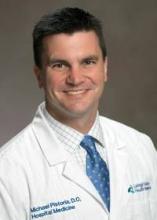Dr. Michael J. Pistoria’s pet peeve is when physicians and nurses talk at patients instead of talking with them.
Less than a year after taking the helm as president of the medical staff at Lehigh Valley Health Network in Allentown, Pa., Dr. Pistoria has urged his colleagues to use plain language when speaking to patients about their treatment. That means avoiding technical terms that require at least a year of medical school to understand. But it also means using communication techniques like "teach-back" to make sure that patients understand what they have been told and have a plan for managing their illness outside the hospital.
He and his colleagues at Lehigh Valley have tested the teach-back concept among heart failure patients and found that it decreased readmissions. In their study, 180 heart failure patients received the teach-back intervention and had a readmission rate of about 7%, while 289 heart failure patients who didn’t receive teach-back had a readmission rate of roughly 10% during the same time period.
In an interview with Hospitalist News, Dr. Pistoria explained the key to their success.
Question: You had some encouraging results in using teach-back with heart failure patients in 2011. Why does this method work so well?
Dr. Pistoria: One factor is the engagement of the nursing staff. It’s a nurse-driven process. The other factor is the engagement of the patient or the key learner. As the teach-back process was developed, we tried to be very cognizant of how much we already ask nurses to do. The two people who spearheaded the approach were Paula Robinson, R.N., and Debra Peter, R.N. They did a great job of tapping into what the nurses were passionate about, which is teaching. This gave them the opportunity to do that in little bits each day for our heart failure patients.
For the patients, teach-back meant having a different level of accountability and involvement. We asked the heart failure patients: "After you leave the hospital, how are you going to remember to weigh yourself every day? How are you going to remember to minimize your salt intake?" I think that really empowered them.
Question: You are looking at the role of teach-back in other conditions. How is that going so far?
Dr. Pistoria: We just rolled out the stroke teach-back on May 1. We’re still working on myocardial infarction and developing teach-back around anticoagulation. We’re also working on a program for obstructive lung disease.
Question: What’s the role for the hospitalist in teach-back?
Dr. Pistoria: They should be involved. We’ve started to have some discussions around how to do that. Right now, our nurses are doing the teach-back, and they may identify particular issues that the patient may be comfortable only expressing to the nurse. The issue then becomes, how do we take those issues and apply some techniques of motivational interviewing on the physician side?
Question: Do you need to use standardized questions for teach-back?
Dr. Pistoria: It’s absolutely necessary. As the teach-back questions were developed, we made sure that everyone was using the same standard work questions and that there was standard work for the process. Then we incorporated the questions with prompters into our order entry system. There’s a pop-up screen on the system that the nurse will see so if they forget the specific question, it’s right there in front of them. They can either read it or work off of it to fit their particular style. Having the standard question and the standard work also is important because it allows us to evaluate and audit to make sure the teach-back is being done correctly.
Question: Everyone is looking for the silver bullet in reducing unnecessary readmissions. Is this it?
Dr. Pistoria: Sadly, it’s not. I think it’s a very important piece and one that we as physicians have not addressed particularly well. Too often we’re not cognizant of the message we’re giving patients and how we’re delivering that message. It’s really important for us to begin to engage patients whether it’s through teach-back or motivational interviewing or something else. This is an important element, but there are just so many other factors that impact readmissions. As much as I would love to say it’s the answer, it’s just one small piece of the puzzle.
Take us to your leader. Nominate a hospitalist whose work inspires you. E-mail suggestions to m.schneider@elsevier.com. Read previous columns at ehospitalistnews.com.

